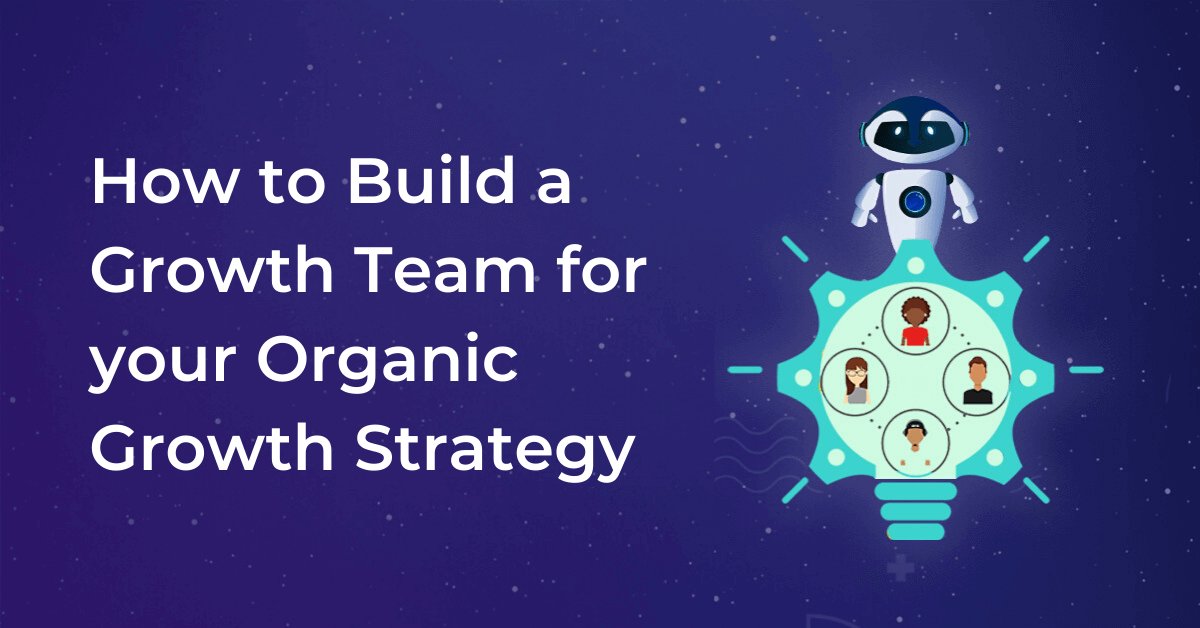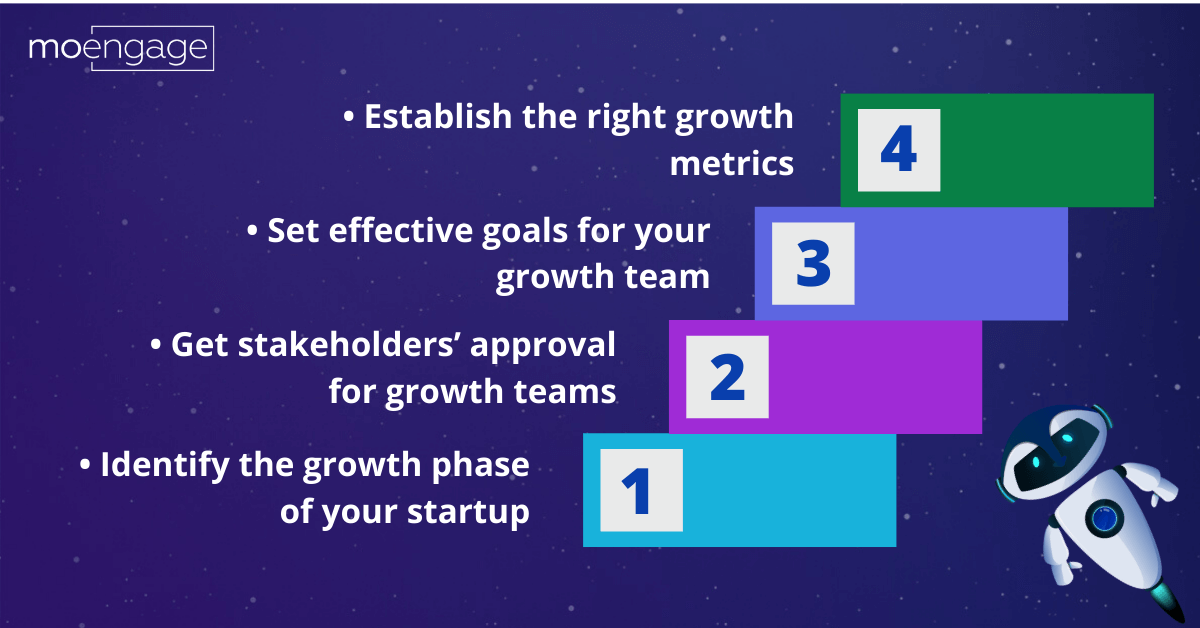Organic Growth Strategy: 4 Steps to Build a Growth Team in 2022

Reading Time: 5 minutes
| Download the Growth Strategy Handbook – A guide to setting up teams, processes & technology stack for your growth program.
Watch Webinar – 4 Ways To Energize Your Organic App Growth. Watch Webinar – How to Setup Growth and CRM Teams to Succeed. Take the interactive quiz – Learn how to scale and build a Growth program with this interactive quiz. |
In the previous blog, we learnt what growth teams are and what they do. We also saw how they have been an integral part of the organic growth strategy of industry giants such as Facebook, Google, Dropbox etc.
The cross functional nature of such teams builds a growth mindset throughout the organization. Because such teams are adept at testing hypotheses through quick experiments, they are ideal for growth hacking in early stages of a business or while launching a new product.01
However, before you get carried away with the exponential growth that a growth mindset team can bring to your organization, it is important that your business has all the necessary conditions that allow growth teams to function effectively. Read on to learn how to build a foundation for growth in your organization.
| Think you’re aware of all Growth Strategy principles? Take this interactive quiz below (don’t worry, you won’t be redirected to another page – you can take the quiz right here)Take Quiz |
Step #1: Identify the Growth Phase of Your Startup
Do you know what phase your startup is in? Figuring this out is the first step. To best utilize growth focussed teams, you should look at introducing them when your product has reached the stage of product-market fit. When your business has reached this stage, it means that you have found the target audience that your product serves.
In the product-market fit stage, all members of a growth mindset team, including sales and marketing team can contribute meaningfully. Introducing growth team model at this stage has allowed them to assimilate early and create opportunities for organic growth even in large organizations such as Facebook.
It is not necessary that an organization must have only one growth team. The number of members in a team can also vary. Use the following as guidelines for setting up growth teams:
- If your company is a newly formed startup, having a three-member team dedicated to growth and working directly with the CEO should suffice.
- Once your business operations grow, consider expanding your growth team to five to ten dedicated members led by a team leader and reporting to the CEO.
- If your company is an established enterprise, having multiple growth teams reporting to a VP of Growth, who reports to the CEO, is essential.
Uber is a great example of organic growth focus through full-fledged growth teams. At one point, Uber had a growth team of 100+ employees from various disciplines such as marketing, design, engineering etc. reporting to a VP of Growth. By creating a significant growth mindset team, Uber was able to focus on building a seamless customer experience and achieve rapid growth through instant feedback and iteration.
Step #2: Get Stakeholders’ and Leadership Approval for Growth Teams
Growth teams exist in order to generate the most creative and impactful solutions to grow a business.
A growth team is meant to be fearless and take risks. Therefore, the solutions that such teams propose need the full support and backing of leaders and other stakeholders in the organization. In the absence of leadership buy in, implementation of solutions is bound to fail, if it takes off at all.
Facebook, a pioneer of the concept of separate growth teams, is a good example of effective leadership involvement. Growth mindset teams in the organization were successful because top leaders set clear goals for each department. This enabled the teams to flourish without stepping on each others’ toes.
The out-of-the-box, high-reward solutions that businesses expect growth focused teams to come up with will only work if they are aligned with the top leadership team no matter where they are placed in the organization structure.

Step #3: Set Effective Goals for Your Growth Team
Once you have figured out the role and value of growth teams to your business, it is time to set goals. Suitable goals define the KPIs of the growth team. Specific goals that are a part of your growth funnel become the measures for monitoring the effectiveness of the growth team. Moreover, establishing goals is an integral part of performance management process which gives your team necessary motivation to desire to grow. Even a company the size of Facebook cannot afford to go easy on goals since they define the path the business takes.
The most common debate while setting goals is whether to chase an absolute number or look at relative growth rates or percentages. We say, go with an absolute number (eg. $20 million revenue instead of 10% YoY revenue growth). That way, you can divide the goals into sub goals among team members and get the entire funnel to focus on hitting that number.
Another thing to be mindful of while setting goals for a growth mindset team is ensuring they are achievable and realistic. Goals that are either too easy to achieve or unrealistic defeat the purpose of targeting an absolute number since they fail to motivate team members.
Step #4: Establish the Right Growth Metrics
Growth teams in successful organizations such as Facebook are known to focus on a single key metric, often called the North Star metric. Every test that the team conducts assesses the improvement in this metric. The key metric for your organization needn’t be the same as that of another organization; you must define it based on the nature of your business. In the growth stage, key metrics are usually related to customer acquisition.
Since growth focused teams are multidisciplinary in nature, metrics must be defined in a way that enables contributions from every relevant function. The right metrics create holistic and sustainable growth across the funnel in an organization. For customer-facing businesses, it is a good idea to divide the absolute goal into supply side and demand side goals, especially if you have separate teams working on each side.
Growth mindset teams at social networking and content platforms such as Facebook typically have Monthly Active Users and Time Spent on Platform as metrics. On the other hand, Airbnb focuses on room nights per day. Metrics such as Active Customers but also Paying Customers are more effective in subscription-based businesses based on the freemium model since they drive revenue for the business.
Conclusion
To conclude, if you are thinking of setting up a growth team in your organization, make sure you get the basics right first. Evaluate the stage of the business to decide how many growth-focused teams you need. Set your teams up for success through the right goals with effective growth metrics, and the support of leaders and key stakeholders. If you have growth teams reporting to functional heads such as Marketing or Product, having clear and distinct responsibilities is the easiest way to get everyone on board, toward a singular growth goal.
Upcoming blogs covering various models of growth teams will give you a better understanding of where and how to best utilize such teams for your business. In the next blog, we will talk about different team structures of growth focussed teams.
What should you do next?
- Get the entire ‘Growth Strategy Handbook’ that talks about setting up different aspects of people, processes, and technology.
- Watch our playlist on Growth strategies by leaders from different industries.
- Take an interactive quiz and assess your knowledge of growth strategy principles.
Related Stories –













